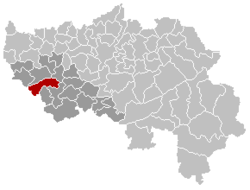County of Huy
|
Huy Hoei (Dutch) |
|||
|---|---|---|---|
| Municipality | |||
 |
|||
|
|||
| Location in Belgium | |||
| Coordinates: 50°31′N 05°14′E / 50.517°N 5.233°ECoordinates: 50°31′N 05°14′E / 50.517°N 5.233°E | |||
| Country | Belgium | ||
| Community | French Community | ||
| Region | Wallonia | ||
| Province | Liège | ||
| Arrondissement | Huy | ||
| Government | |||
| • Mayor | Alexis Housiaux (PS) | ||
| • Governing party/ies | PS, MR | ||
| Area | |||
| • Total | 47.74 km2 (18.43 sq mi) | ||
| Population (1 January 2016) | |||
| • Total | 21,292 | ||
| • Density | 450/km2 (1,200/sq mi) | ||
| Postal codes | 4500 | ||
| Area codes | 085 | ||
| Website | www.huy.be | ||
Huy (pronounced: [ɥi]; Dutch: Hoei; Walloon: Hu) is a municipality of Belgium. It lies in the country's Walloon Region and Province of Liege. Huy lies along the river Meuse, at the mouth of the small river Hoyoux. It is in the sillon industriel, the former industrial backbone of Wallonia, home to about two-thirds of the Walloon population. The Huy municipality includes the sub-municipalities of Ben-Ahin, Neuville-sous-Huy, and Tihange.
The first village originated around the Roman castrum, an early fortress located on the right bank of the River Meuse. The village was evangelized by Saint Domitian, bishop of Tongeren in the 6th century and the town is mentioned for the first time in a 7th-century testament.
In the early Middle Ages, Huy was one of the most prosperous cities on the Meuse, with a flourishing economy based mostly on metallurgy, but also on tanning, sculpting, woodworking, and wine-making. In the 10th century, Huy was promoted to county status, but soon became part of the Prince-Bishopric of Liège, with which it would share its history for more than eight centuries. Huy was the recipient of the first historically known charter north of the Alps, confirming it as a city in 1066. It is around that time that Peter the Hermit harangued the locals and persuaded them to participate in the First Crusade.
...
Wikipedia




